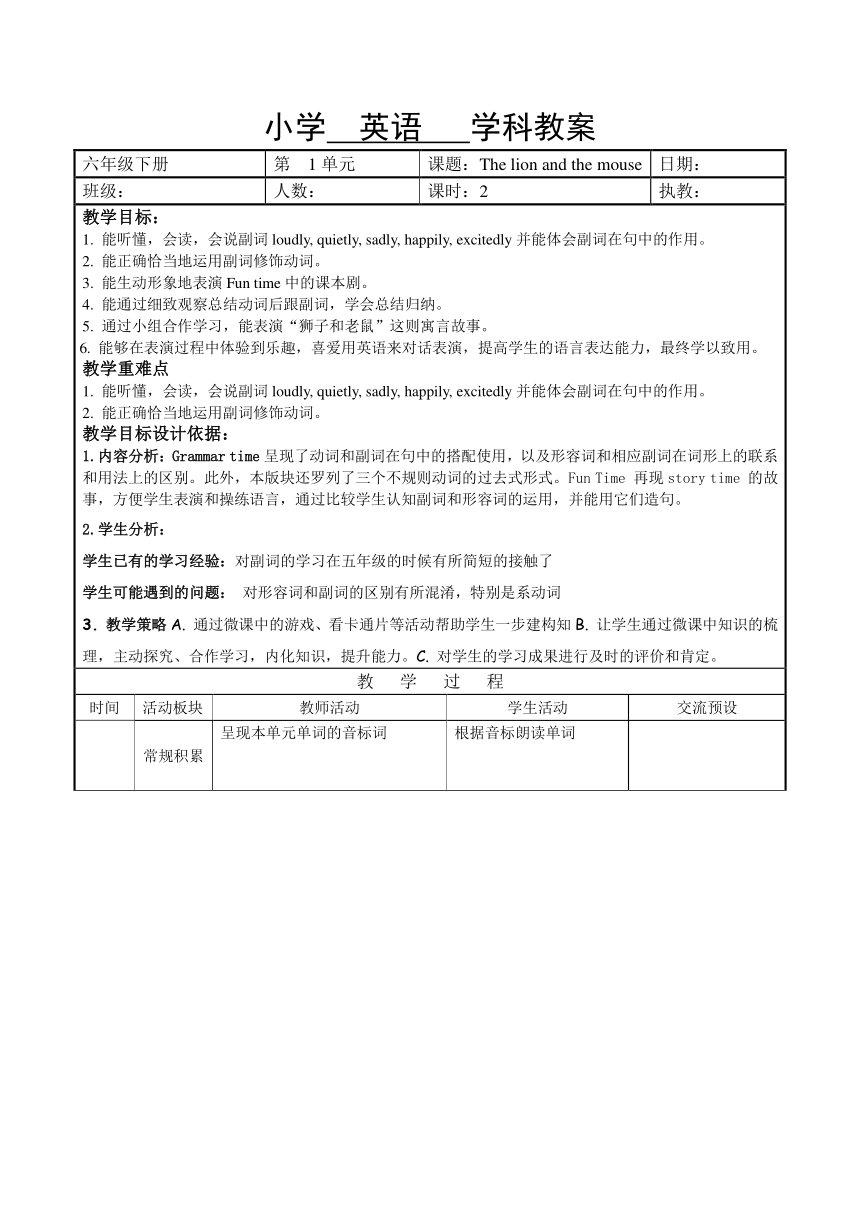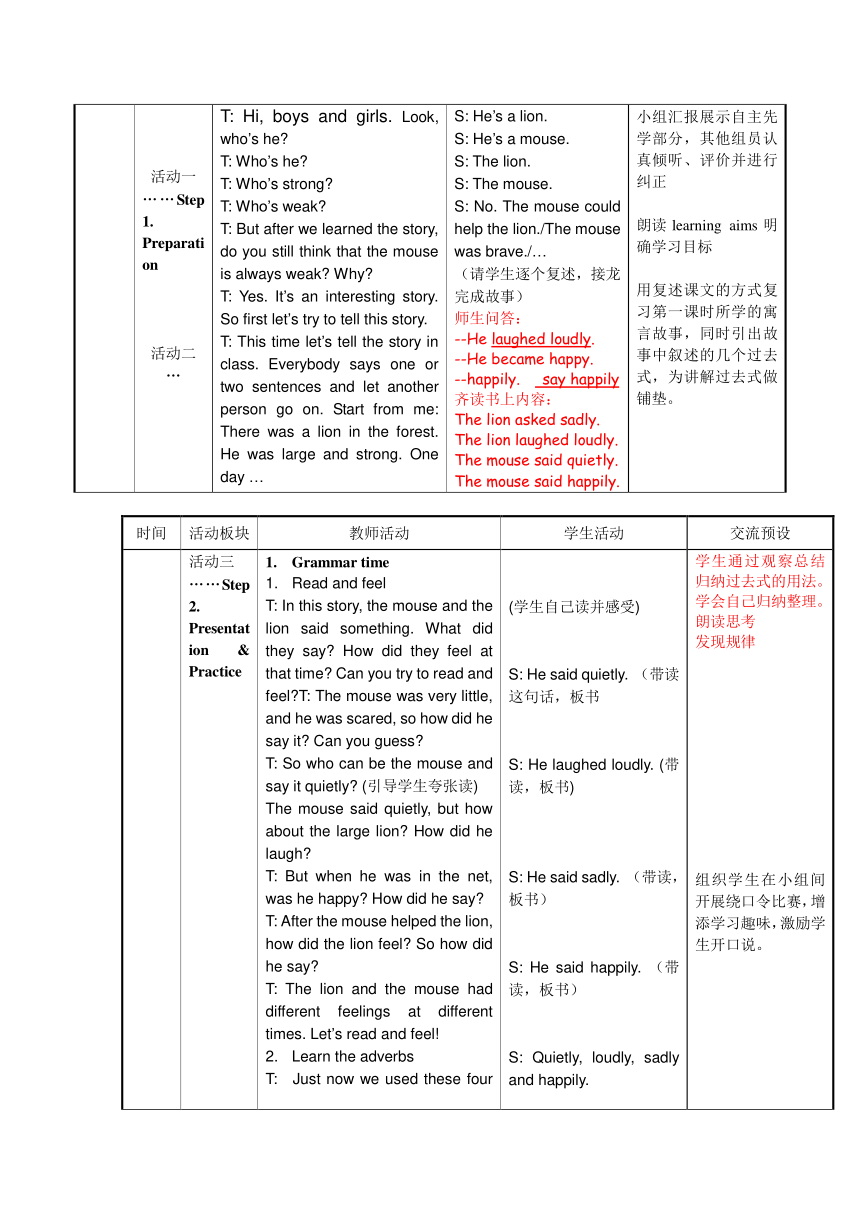Unit 1 The lion and the mouse Lesson 2 教学设计(表格式)
文档属性
| 名称 | Unit 1 The lion and the mouse Lesson 2 教学设计(表格式) |  | |
| 格式 | docx | ||
| 文件大小 | 27.4KB | ||
| 资源类型 | 教案 | ||
| 版本资源 | 牛津译林版 | ||
| 科目 | 英语 | ||
| 更新时间 | 2024-06-17 21:07:19 | ||
图片预览


文档简介
小学 英语 学科教案
六年级下册 第 1单元 课题:The lion and the mouse 日期:
班级: 人数: 课时:2 执教:
教学目标: 1. 能听懂,会读,会说副词loudly, quietly, sadly, happily, excitedly并能体会副词在句中的作用。 2. 能正确恰当地运用副词修饰动词。 3. 能生动形象地表演Fun time中的课本剧。 4. 能通过细致观察总结动词后跟副词,学会总结归纳。 5. 通过小组合作学习,能表演“狮子和老鼠”这则寓言故事。 ( 6. 能够在表演过程中体验到乐趣,喜爱用英语来对话表演,提高学生的语言表达能力,最终学以致用。 教学重难点 1. 能听懂,会读,会说副词loudly, quietly, sadly, happily, excitedly并能体会副词在句中的作用。 2. 能正确恰当地运用副词修饰动词。 教学目标设计依据: 1.内容分析:Grammar time呈现了动词和副词在句中的搭配使用,以及形容词和相应副词在词形上的联系和用法上的区别。此外,本版块还罗列了三个不规则动词的过去式形式。Fun Time 再现story time 的故事,方便学生表演和操练语言,通过比较学生认知副词和形容词的运用,并能用它们造句。 2.学生分析: 学生已有的学习经验:对副词的学习在五年级的时候有所简短的接触了 学生可能遇到的问题: 对形容词和副词的区别有所混淆,特别是系动词 3. 教学策略A. 通过微课中的游戏、看卡通片等活动帮助学生一步建构知B. 让学生通过微课中知识的梳理,主动探究、合作学习,内化知识,提升能力。C. 对学生的学习成果进行及时的评价和肯定。
教 学 过 程
时间 活动板块 教师活动 学生活动 交流预设
常规积累 呈现本单元单词的音标词 根据音标朗读单词
活动一 ……Step 1. Preparation 活动二 … T: Hi, boys and girls. Look, who’s he T: Who’s he T: Who’s strong T: Who’s weak T: But after we learned the story, do you still think that the mouse is always weak Why T: Yes. It’s an interesting story. So first let’s try to tell this story. T: This time let’s tell the story in class. Everybody says one or two sentences and let another person go on. Start from me: There was a lion in the forest. He was large and strong. One day … S: He’s a lion. S: He’s a mouse. S: The lion. S: The mouse. S: No. The mouse could help the lion./The mouse was brave./… (请学生逐个复述,接龙完成故事) 师生问答: --He laughed loudly. --He became happy. --happily. say happily 齐读书上内容: The lion asked sadly. The lion laughed loudly. The mouse said quietly. The mouse said happily. 小组汇报展示自主先学部分,其他组员认真倾听、评价并进行纠正 朗读learning aims明确学习目标 用复述课文的方式复习第一课时所学的寓言故事,同时引出故事中叙述的几个过去式,为讲解过去式做铺垫。
时间 活动板块 教师活动 学生活动 交流预设
活动三 ……Step 2. Presentation & Practice Step 4. Production Grammar time Read and feel T: In this story, the mouse and the lion said something. What did they say How did they feel at that time Can you try to read and feel T: The mouse was very little, and he was scared, so how did he say it Can you guess T: So who can be the mouse and say it quietly (引导学生夸张读) The mouse said quietly, but how about the large lion How did he laugh T: But when he was in the net, was he happy How did he say T: After the mouse helped the lion, how did the lion feel So how did he say T: The lion and the mouse had different feelings at different times. Let’s read and feel! Learn the adverbs T: Just now we used these four words. T: They are adverbs. (带读,板书) We can say ‘The mouse said.’ It’s OK. But why do we say ‘The mouse said quietly.’ What are the adverbs for T: And look(板书), do we often put them before or after the verbs T: And we can get some adverbs from the adjectives. You know excitedly. What does it mean Can you tell us in English T: Look at the adverbs. Can you find any rules T: And sometimes they end up with ‘ily’. Fun time 1. Before acting T: You showed your ideas excitedly. And how about this lion He was excited, too. What did he say T: So at that time, how did he say it T: I think you are all right, and I guess maybe he said excitedly.(出示excitedly的卡片) But did the animals say excitedly, too (2. Let’s act T: You’ve well prepared, so let’s try to act. Let’s act in three, a lion, a mouse and a narrator. The narrator is very important because he can use the adverbs to show the actions vividly. T: How could it be T: Look, in the forest, there came a cat one day. Who was not happy T: So could the lion help his friend this time What would happen among them Let’s imagine and make a short play. (学生自己读并感受) S: He said quietly. (带读这句话,板书 S: He laughed loudly. (带读,板书) S: He said sadly. (带读,板书) S: He said happily. (带读,板书) S: Quietly, loudly, sadly and happily. S: (引导学生)They can show the actions more vividly. S: we often put adverbs after the verbs. (学生快速说,读词,贴板书。) S: It means very, very happily 看图独立完成: The boy is running fast. The girl is shouting excitedly. The children are talking loudly. The people are laughing happily. The man is reading carefully. The woman is crying sadly. 全班交流和齐读 观察后交流: 形容词后加ly 形容词修饰名词,副词修饰动词或形容词 在教师引导下归纳四种构成: a. 词尾直接加ly b. 去e加ily c. 不变 d. 不规则 (教师做旁白,请两个学生扮演狮子和老鼠,示范第一幅图,之后学生三人小组表演,请学生上台反馈) S: Yes./No. S: … S: The mouse. (学生四人小组编短剧,并上台表演) 学生通过观察总结归纳过去式的用法。学会自己归纳整理。朗读思考 发现规律 组织学生在小组间开展绕口令比赛,增添学习趣味,激励学生开口说。 学生自己总结归纳整理副词修饰动词并且读一读,体会发音规则。 看图说话或编对话环节提供一些词汇和句型帮助学生更好地完成语言输出。让学生体会创作和表演的乐趣。 鼓励学生根据图片,发挥想象力,拓展对话内容,丰富人物的语言和动作。 小组合作表演对话,给予“Good, Great, Excellent”不同层次的评价。 当堂练习进行巩固 重点关注副词和形容词的用法和区别
三、练习设计 1. Copy and remember the adverbs we learned today. 2. Surf the Internet and get to know more adverbs. 3. Finish the story of ‘The lion, the cat and the mouse’ 练习指导
板书设计: Unit 1 The lion and the mouse The mouse said quietly. The lion laughed loudly. The lion asked sadly. The lion said happily.
六年级下册 第 1单元 课题:The lion and the mouse 日期:
班级: 人数: 课时:2 执教:
教学目标: 1. 能听懂,会读,会说副词loudly, quietly, sadly, happily, excitedly并能体会副词在句中的作用。 2. 能正确恰当地运用副词修饰动词。 3. 能生动形象地表演Fun time中的课本剧。 4. 能通过细致观察总结动词后跟副词,学会总结归纳。 5. 通过小组合作学习,能表演“狮子和老鼠”这则寓言故事。 ( 6. 能够在表演过程中体验到乐趣,喜爱用英语来对话表演,提高学生的语言表达能力,最终学以致用。 教学重难点 1. 能听懂,会读,会说副词loudly, quietly, sadly, happily, excitedly并能体会副词在句中的作用。 2. 能正确恰当地运用副词修饰动词。 教学目标设计依据: 1.内容分析:Grammar time呈现了动词和副词在句中的搭配使用,以及形容词和相应副词在词形上的联系和用法上的区别。此外,本版块还罗列了三个不规则动词的过去式形式。Fun Time 再现story time 的故事,方便学生表演和操练语言,通过比较学生认知副词和形容词的运用,并能用它们造句。 2.学生分析: 学生已有的学习经验:对副词的学习在五年级的时候有所简短的接触了 学生可能遇到的问题: 对形容词和副词的区别有所混淆,特别是系动词 3. 教学策略A. 通过微课中的游戏、看卡通片等活动帮助学生一步建构知B. 让学生通过微课中知识的梳理,主动探究、合作学习,内化知识,提升能力。C. 对学生的学习成果进行及时的评价和肯定。
教 学 过 程
时间 活动板块 教师活动 学生活动 交流预设
常规积累 呈现本单元单词的音标词 根据音标朗读单词
活动一 ……Step 1. Preparation 活动二 … T: Hi, boys and girls. Look, who’s he T: Who’s he T: Who’s strong T: Who’s weak T: But after we learned the story, do you still think that the mouse is always weak Why T: Yes. It’s an interesting story. So first let’s try to tell this story. T: This time let’s tell the story in class. Everybody says one or two sentences and let another person go on. Start from me: There was a lion in the forest. He was large and strong. One day … S: He’s a lion. S: He’s a mouse. S: The lion. S: The mouse. S: No. The mouse could help the lion./The mouse was brave./… (请学生逐个复述,接龙完成故事) 师生问答: --He laughed loudly. --He became happy. --happily. say happily 齐读书上内容: The lion asked sadly. The lion laughed loudly. The mouse said quietly. The mouse said happily. 小组汇报展示自主先学部分,其他组员认真倾听、评价并进行纠正 朗读learning aims明确学习目标 用复述课文的方式复习第一课时所学的寓言故事,同时引出故事中叙述的几个过去式,为讲解过去式做铺垫。
时间 活动板块 教师活动 学生活动 交流预设
活动三 ……Step 2. Presentation & Practice Step 4. Production Grammar time Read and feel T: In this story, the mouse and the lion said something. What did they say How did they feel at that time Can you try to read and feel T: The mouse was very little, and he was scared, so how did he say it Can you guess T: So who can be the mouse and say it quietly (引导学生夸张读) The mouse said quietly, but how about the large lion How did he laugh T: But when he was in the net, was he happy How did he say T: After the mouse helped the lion, how did the lion feel So how did he say T: The lion and the mouse had different feelings at different times. Let’s read and feel! Learn the adverbs T: Just now we used these four words. T: They are adverbs. (带读,板书) We can say ‘The mouse said.’ It’s OK. But why do we say ‘The mouse said quietly.’ What are the adverbs for T: And look(板书), do we often put them before or after the verbs T: And we can get some adverbs from the adjectives. You know excitedly. What does it mean Can you tell us in English T: Look at the adverbs. Can you find any rules T: And sometimes they end up with ‘ily’. Fun time 1. Before acting T: You showed your ideas excitedly. And how about this lion He was excited, too. What did he say T: So at that time, how did he say it T: I think you are all right, and I guess maybe he said excitedly.(出示excitedly的卡片) But did the animals say excitedly, too (2. Let’s act T: You’ve well prepared, so let’s try to act. Let’s act in three, a lion, a mouse and a narrator. The narrator is very important because he can use the adverbs to show the actions vividly. T: How could it be T: Look, in the forest, there came a cat one day. Who was not happy T: So could the lion help his friend this time What would happen among them Let’s imagine and make a short play. (学生自己读并感受) S: He said quietly. (带读这句话,板书 S: He laughed loudly. (带读,板书) S: He said sadly. (带读,板书) S: He said happily. (带读,板书) S: Quietly, loudly, sadly and happily. S: (引导学生)They can show the actions more vividly. S: we often put adverbs after the verbs. (学生快速说,读词,贴板书。) S: It means very, very happily 看图独立完成: The boy is running fast. The girl is shouting excitedly. The children are talking loudly. The people are laughing happily. The man is reading carefully. The woman is crying sadly. 全班交流和齐读 观察后交流: 形容词后加ly 形容词修饰名词,副词修饰动词或形容词 在教师引导下归纳四种构成: a. 词尾直接加ly b. 去e加ily c. 不变 d. 不规则 (教师做旁白,请两个学生扮演狮子和老鼠,示范第一幅图,之后学生三人小组表演,请学生上台反馈) S: Yes./No. S: … S: The mouse. (学生四人小组编短剧,并上台表演) 学生通过观察总结归纳过去式的用法。学会自己归纳整理。朗读思考 发现规律 组织学生在小组间开展绕口令比赛,增添学习趣味,激励学生开口说。 学生自己总结归纳整理副词修饰动词并且读一读,体会发音规则。 看图说话或编对话环节提供一些词汇和句型帮助学生更好地完成语言输出。让学生体会创作和表演的乐趣。 鼓励学生根据图片,发挥想象力,拓展对话内容,丰富人物的语言和动作。 小组合作表演对话,给予“Good, Great, Excellent”不同层次的评价。 当堂练习进行巩固 重点关注副词和形容词的用法和区别
三、练习设计 1. Copy and remember the adverbs we learned today. 2. Surf the Internet and get to know more adverbs. 3. Finish the story of ‘The lion, the cat and the mouse’ 练习指导
板书设计: Unit 1 The lion and the mouse The mouse said quietly. The lion laughed loudly. The lion asked sadly. The lion said happily.
